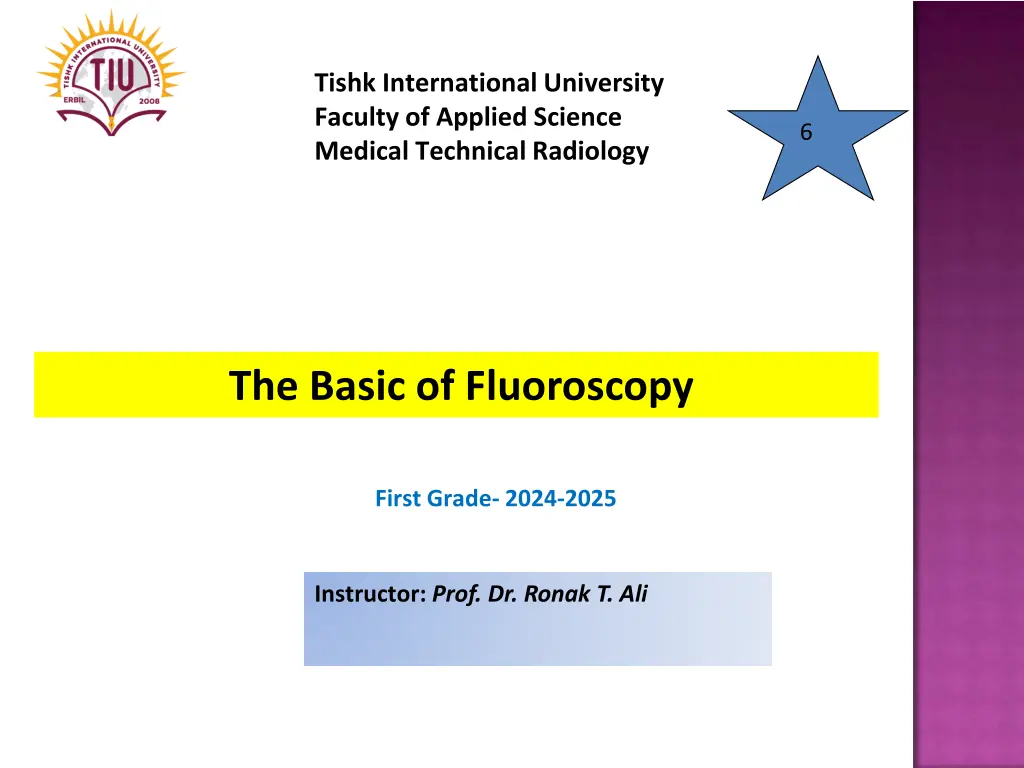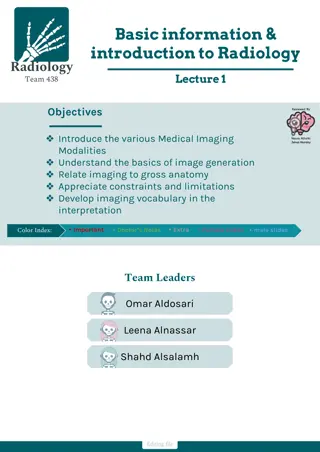
Understanding Fluoroscopy in Radiology: A Dynamic Imaging Technique
Explore the world of fluoroscopy, a dynamic imaging technique used in radiology to visualize moving internal structures and fluids in real-time. Learn how it differs from traditional x-rays, its applications, and the importance of managing scattered radiation exposure.
Download Presentation

Please find below an Image/Link to download the presentation.
The content on the website is provided AS IS for your information and personal use only. It may not be sold, licensed, or shared on other websites without obtaining consent from the author. If you encounter any issues during the download, it is possible that the publisher has removed the file from their server.
You are allowed to download the files provided on this website for personal or commercial use, subject to the condition that they are used lawfully. All files are the property of their respective owners.
The content on the website is provided AS IS for your information and personal use only. It may not be sold, licensed, or shared on other websites without obtaining consent from the author.
E N D
Presentation Transcript
Tishk International University Faculty of Applied Science Medical Technical Radiology 6 The Basic of Fluoroscopy First Grade- 2024-2025 Instructor: Prof. Dr. Ronak T. Ali
Study of moving body structures. Similar to an x-ray Fluoroscopy is also an imaging tool. Allows physicians to look at various body systems.
Show continuous x- ray image Plays out like a movie Images taken quickly allow for this to happen Shows movement of body parts Also shows instruments or dye
The primary function of a fluoroscope is to perform dynamic studies; that is, the fluoroscope is used to visualize the motion of internal structures and fluids. The purpose of this technique is to get real-time and moving images of the insides of a person by way of the fluoroscope. If something is observed that the radiologist would like to preserve for later study, a radiograph can be made with little interruption of fluoroscopic examination. Such a radiograph is known as spot film.
Scatteredradiation There are three types of X rays: primary X rays : are released from the X -ray tube scattered X rays : are scattered from the primary substance and occur as a result of collision of electrons; residual radiation : is X -rays that pass through the patient and strengthen the image.
Scatteredradiation If the X -ray tube is on the patient and at eye level to the physician performing the scanning, the physician s face is relatively close to the X -ray tube and is unprotected against radiation leaks scattered from the tube. The image booster, if it is positioned above the patient, also serves as a barrier to protect the physician sface. in this position the tube is placed below the patient, back scattering also occurs toward the ground 7
Scatteredradiation Fluoroscopy devices that automatically determine the beam settings also automatically adjust the tube potential (kV) with increasing thickness of the patient sbody With an increase in tube potential, the force of the primary beam increases and scattering radiation will be more penetrating 8
Fluoroscopy usage types 1. Continuousfluoroscopy: found in all the old machines, and is still a format that is used. Fluoroscopy continues as long as the pedal is helddown. This format is used incorrectly by many physicians. From the aspect of radiation safety, this is very dangerous. 2. High-speed fluoroscopy: used in situations where normal fluoroscopy is inadequate. it is not recommended. 3. Pulsed fluoroscopy: The image speed and frames per second rate (fps) is selected. This is the most advantageousformat. 9
Takes a continuing stream of x-ray images Approximately 25- 30 images per second Images are viewed on a monitor Sort of like a television screen.
Amount of radiation needed various Based on procedure Important characteristic of Fluoroscopy Sensitivity Amount of exposure needed to create animage Non-intensified Fluoroscopy Uses a fluorescent screen only for a receptor Should not be used because of excessiveexposure
Components of Fluoroscope x-ray generator x-ray tube collimator filters patient table grid image intensifier optical coupling television system image recording
Used in a variety of procedures Examples include: Orthopedic Surgery Observe fractures and healingbones Catheter Insertion Direct catheter placement (Angiography/Angioplasty) Barium X-Rays Observe movement through GI tract Blood Flow Studies View blood flow to organs
Injections into the knees Viscosupplementation injections Locating foreign bodies Percutaneous Vertebroplasty Treating compressed fractures of the spine Injections into joints or spine Image-guided anesthetic injections
Fluoroscopy used alone Gives physician opportunity to see movement in the intestines Barium moves through them during procedure
Fluoroscopy used alone Aids physicians in inserting a catheter Also aids them in detecting blockages in arteries Physicians can see the flow of blood
Because Fluoroscopy is an x-ray machine, it has the same risks as other x-ray machines. Two major risks There is a small possibility of developing cancer due to the exposure to the radiation Injuries such as burns caused by the radiation Benefit If a patient is in need of a Fluoroscopy, the benefit outweighs the minute risks
Insertion of an IV into patients hand or arm Patient moved onto x-ray table Additional line may be inserted for catheter procedures X-Ray scanner used to create fluoroscopic images of the body Dye may be injected into the IV at this point Type of care will be decided on after the procedure has finished
Continuous x-ray passes through the body Beam passes onto a television monitor Body part and motion can be seen in great detail
Two main things to consider Area most exposed Total radiation absorbed Area Most Exposed Highest absorbed dose In the general area, as well as specific organs Total Radiation absorbed Can result in injuries Burns, etc. Caused by prolong exposure
Fluoroscopy is also an imaging tool. Allows physicians to look at various body systems. Shows movement of body parts. Also shows instruments or dye Takes a continuing stream of x-ray images. Approximately 25-30 images per second Used in a variety of procedures Orthopedic Surgery Catheter Insertion Barium X-Rays Blood Flow Studies
Two major risks There is a small possibility of developing cancer due to the exposure to the radiation Injuries such as burns caused by the radiation Benefit outweighs the risks Precise procedure Plenty of steps followed to ensure a successful procedure Plenty to consider during procedure Area Most Exposed Total Radiation absorbed
Effects of radiation on biological systems Radiation effects on biological systems are divided into two Groups: Cytocastic Determining (direct, definitive) effect (indirect, nondefinitive) effect
Cytocastic (indirect, nondefinitive) effect The International Committee on Radiation Safety Protection ICRP has produced estimates of the maximum permissible dose (MPD) of annual radiation to various organs Exposure below these levels is unlikely to lead to any significant effects the ICRP recommends that workers should not receive more than 10% of the MPD 24
Radiation safety necessity for imaging or the procedure should be assessed: 1. effectiveness of the procedure 2. personal dose limits 3. risk assessment radiation protection should take into account three basic rules: 1. Time 2. Distance 3. use of protective materials(shielding) 27
Fundamental principles of radiation protection 1. Hold the tube low. 2. Keep away from sources of radiation. 3. Consider the scatteringprofile. 4. Keep the beam time brief. 5. Set the appropriate geometry 6. Eliminate X -rays from the outside 7. The device should undergo technical checks 8. Wear protective clothing. 28
During routine use in the anterior-posterior plane, the x-ray tube (source) should be positioned below the patient and the detector above the patient to minimize radiation exposure to both the patient and the practitioner.
The oblique projection results in markedly increased exposure to the practitioner
1. During use in the lateral projection, the practitioner should step completely behind the x-ray tube (source) to minimize radiation exposure. 2. When it is necessary to work close to the patient during lateral fluoroscopy, the practitioner should step away from the x-ray tube and move to the side of the table opposite the x- ray tube to minimize exposure DR MOHSEN ABAD 55
Radiation exposure to both the patient and the practitioner is dramatically increased when the x-ray tube (source) is inverted above the patient. Some practitioners invert the (-arm to allow for more extreme lateral angle (e.g., rotation beyond 35 to 45 degrees oblique to the side opposite the (-arm is not possible without inverting the (-arm on some units). Radiation exposure can be reduced by rotating the patient on the table and keeping the x-ray source below the table.
Keep away from sources of radiation what is a safe distance? stand 3 meters away from the table to reduce the beam level that can be absorbed to an acceptable level. best place to stand for staff is where the X -ray scatters twice before it reaches them radiation intensity decreases approximately 1000 times with each scatteringevent in other words one -millionth of the original value 33
Every fluoroscopy operator should do the following 1. Track the beam time: The C -arms of fluoroscopy devices have an irradiation alarm that sounds for every 5 minutes of irradiation 2. Save the last image: Storing the last image in memory in this manner will significantly reduce the radiation dose Pressing the pedal for a long time is not a factor in increasing quality the image brightness, or contrast. 3. Use the pulse mode: two different modes, continuous and pulse. In pulse mode imaging, intermittent versus continuous radiation. This mode reduces the irradiation time by up to 2 to 4 times. 34
Every fluoroscopy operator should do the following 4. Limit the beam size (collimation) If possible, should restrict the irradiated area by reducing the diaphragm or with the collimator. This process reduces the amount of scattered radiation and improves the image quality 5. Set the appropriate geometry: If the X -ray tube is brought too close to the patient, it can cause skin burns during long -term applications if the X-ray tube is too far from the patient, this can increase the size of the image As a rule, doubling the focus distance increases the rate of exposure to radiation fourfold. 35
Every fluoroscopy operator should do the following 6. Eliminate X -rays from the outside: Outside light barriers interacting with the fluoroscopy device can block the image details from being seen. In such a case, the fluoroscopic image needs to be enlarged or the amount of scattered light increased. 7. The device should undergo technical checks: Technical control is very important image intensifier ages automatic brightness control mode 36
Every fluoroscopy operator should do the following 8. Wear protective clothing Elastic protective clothing such as aprons, vests, shirts, skirts, thyroid protectors, and gloves, glasses, are used in stationary or moving environments without shielding they will never completely stop X-rays, only reduce them to an acceptable level At 100 kV, 3.2% of the beam will pass through a 0.5 mm lead shirt, and at 70 kV 0.36% willpass. d. if the physician wears a lead apron and gloves but stands in the way of the primary radiation path, full security is not guaranteed e. A lead apron used correctly can offer 80% protection to active blood -producingorgans f. A well -chosen apron should start just below the manubrium sternum to include the pubis symphysis index down to just above the knee. a. b. c. 37
Every fluoroscopy operator should do the following 8. Wear protective clothing g. for the protection to be effective, the face of the person must be turned toward the scattering source h. The physician who is implementing the fluoroscopy procedure should not turn their back on the beam i. reinforced or equivalent materials that are filled with lead, copper, barium, and tungsten j. These aprons should not be folded or wrinkled, and should not be thrown around randomly k. addition, they should be checked every year, including vital areas to ensure there are no cracks or breaks l. To protect against scattered radiation from the patient, two hanging lead curtains next to the sides of the fluoroscopy tables can be used 38






















